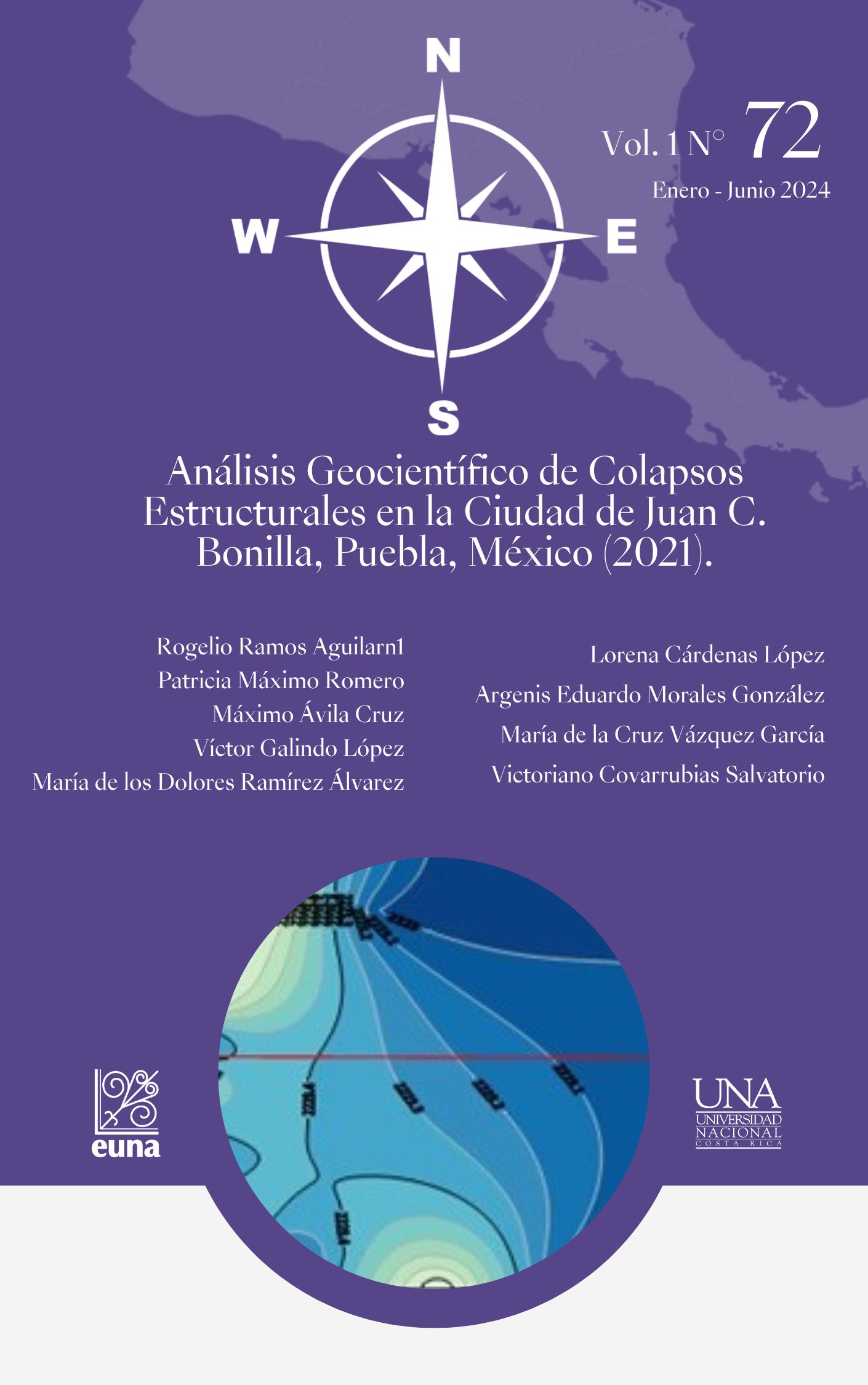Geoscientific Analysis of Structural Collapses in the City of Juan C. Bonilla, Puebla, Mexico (2021)SES IN THE CITY OF JUAN C. BONILLA, PUEBLA, MEXICO (2021).
DOI:
https://doi.org/10.15359/rgac.72-12Keywords:
collapse, geomorphology, geostatistics, acceleration, modelsAbstract
This paper presents a general analysis from the geosciences of structural collapses. The analysis was conducted in the crop fields of Santa María Zacatepec, in the city of Juan C. Bonilla, Mexico. The analysis implemented the Remote Sensing technique, facilitating the interpretation of band combinations and determining the geometry, geology, geomorphology and cartography of the site under study. A summary analysis of the work performed is presented, in addition to showing simulation models of the hydrological outflow and water acceleration in the runoff structural slopes, data that were used for the final mapping and graphic modeling. A geomorphological, geological, and topographical study of the site was conducted, using satellite and aerial telemetric techniques. Specialized software was also used for geodetic surveys, mapping in 2D and 3D models of the analysis area. Surveys of the site were carried out to determine the shape of the structure and identify potentially risk areas for the population near the collapse events. Orthophotos were obtained to calculate and determine the slope by distance-elevation, acceleration-height, water flow and force, which served to conclude the possible causes that led to the collapses and have sufficient technical data that were shared with the civil protection authorities.
References
Instituto Nacional de Estadística y Geografía, INEGI. (2019). Cálculo de gasto o caudal. http://antares.inegi.org.mx/analisis/red_hidro/PDF/CalculoGasto.pdf
Instituto Nacional de Estadística y Geografía, INEGI. (2020). Mapa digital. http://gaia.inegi.org.mx/mdm6/
Máximo-Romero, P., Ramos-Aguilar, R., Martínez-Ortiz, A. y Hernández-Sánchez, A. (2017). Daños estructurales en Ciudad de México, producidos por los sismos del 28 de julio de 1957 y el 19 de septiembre de 1985. Revista UNIMAR, 35(2), 161-186. https://revistas.umariana.edu.co/index.php/unimar/article/view/1533/pdf
Ramos-Aguilar, R., Rivera-Domínguez, A. y Mayorga-Raposo, R. (2005). Aplicación de imágenes satelitales para determinar el clima y la radiación solar en el estado de Puebla y la geohidrología de su zona norte. Ciencia Ergo Sum, 10(003), 283-294. https://www.redalyc.org/pdf/104/10410306.pdf
Ramos-Aguilar, R., Máximo-Romero, P., Narciso-Hernández, J., Mirón-Morales, M. y Beltrán-Cruz, M. (2012). Estudio geoestadístico para obtener la gravedad local, pendiente y cálculo hidrológico de las barrancas Xaltelulco, Tepeloncocone, Tenepanco, Colorada y Quimichule del volcán Popocatépetl. Boletín de Ciencias de La Tierra, (31), 65–84. https://revistas.unal.edu.co/index.php/rbct/article/view/31254
Ramos-Aguilar, R., Máximo-Romero, P., Soto-Cruz, B., Alcántara-Iniesta, S. y Pérez-Luna, J. (2013). Analysis of the Meteorological Variables for Puebla City 2011-2012 Applying the Modeling Ion-Wavelets in a Hypothetical Manner. Atmospheric and Climate Sciences, 3(4), 450–458. https://doi.org/10.4236/acs.2013.34046
Ramos-Aguilar, R., Máximo-Romero, P., Galindo-López, V., Ávila-Cruz, M., Yáñez-Pérez, G., Márquez-Máximo, R., y Covarrubias-Salvatori, V. (2021). Análisis técnico geoestadístico de los ríos Atoyac y Alseseca que atraviesan la ciudad de Puebla, México. Contactos, Revista de Educación en Ciencias e Ingeniería, (119), 5-22. https://contactos.izt.uam.mx/index.php/contactos/article/view/99
Ramos-Aguilar, R., Máximo-Romero, P., Galindo-López, V., Ávila-Cruz, M., Yáñez-Pérez, G., Márquez-Máximo, R., Hernández-Andrade, D. y Covarrubias-Salvatori, V. (2022). Análisis gravimétrico y cálculo de la fuerza de un líquido en el volcán Malinche, Puebla-Tlaxcala, México. Boletín de Ciencias de la Tierra, (49), 9-14. https://doi.org/10.15446/rbct.n49.91906
SIATL, (2019). Institutito Nacional de Estadística y Geografía. http://antares.inegi.org.mx/analisis/red_hidro/siatl
Sinem, E., Barthelmes, F., Reißland, S., Elger, K., Förste, C., Flechtner, F. y Schuh, H. (2019). ICGEM – 15 years of successful collection and distribution of global gravitational models, associated services, and future plans. Earth System Science Data, 11(2), 647–674. https://doi.org/10.5194/essd-11-647-2019

Published
How to Cite
Issue
Section
License
Copyright (c) 2024 Rogelio Ramos Aguilar, Patricia Máximo Romero, Máximo Ávila Cruz, Víctor Galindo López, María de los Dolores Ramírez Álvarez, Lorena Cárdenas López, Argenis Eduardo Morales González, María de la Cruz Vázquez García, Victoriano Covarrubias Salvatori

This work is licensed under a Creative Commons Attribution-NonCommercial-ShareAlike 4.0 International License.
Proposed policy for journals offering Open Access
Authors publishing their works in the Journal acknowledge and agree to the following terms:
a) Authors retain the copyrights to their works and guarantee the Journal the right to be the first to publish their works, under the Creative Commons License Attribution-NonCommercial-ShareAlike 4.0 International, CC BY-NC-SA 4.0 International (https://creativecommons.org/licenses/by-nc-sa/4.0/deed.es), which allows others to share works upon complying with the acknowledgment of authorship and mention of the Journal as the original publisher of the work.
b) Authors are permitted to separately establish additional agreements for the non-exclusive distribution of the official edition of the work published in the Journal (for example, authors may desire to place the work in an institutional repository or incorporate it into a book that is to published elsewhere) so long they acknowledgment to recognize the Journal as the original publisher. The aforementioned additional agreements must respect the terms of the non-profit character and sharing philosophy of the original license (CC BY-NC-SA 4.0 International, https://creativecommons.org/licenses/by-nc-sa/4.0/deed.es).
c) Authors are encouraged to archive the post-print or editor/PDF version in Open Access repositories.





 REVGEO is licensed under https://creativecommons.org/licenses/by-nc-sa/4.0/deed.es
REVGEO is licensed under https://creativecommons.org/licenses/by-nc-sa/4.0/deed.es
.svg_4.png)

_(1).png)
_(1)_(1)_(1)_1.png)
(2)(1)(1)(1).png)
